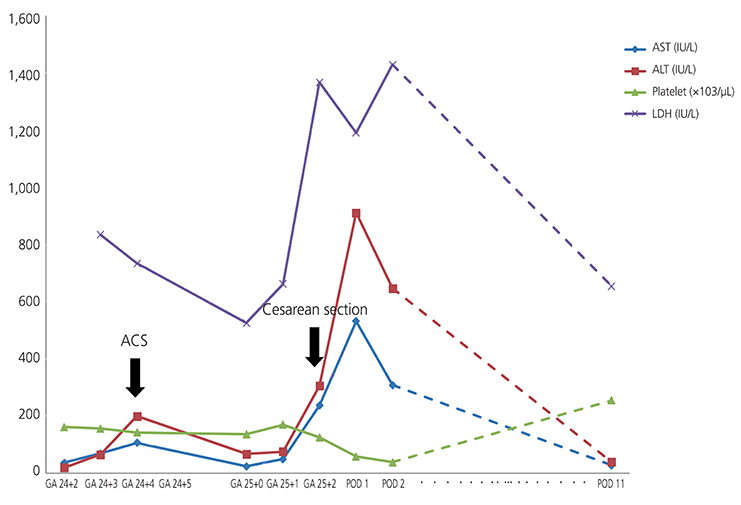Obstet Gynecol Sci.
2016 Sep;59(5):397-402. 10.5468/ogs.2016.59.5.397.
Hepatic infarction in a pregnant woman with antiphospholipid syndrome and triple antibody positivity: A case report focusing on catastrophic antiphospholipid syndrome
- Affiliations
-
- 1Department of Obstetrics and Gynecology, Samsung Medical Center, Sungkyunkwan University School of Medicine, Seoul, Korea. ohsymd@skku.edu
- KMID: 2391691
- DOI: http://doi.org/10.5468/ogs.2016.59.5.397
Abstract
- Pregnant women with antiphospholipid syndrome (APS) carry a high risk of arterial or venous thrombosis. Such thrombotic conditions occur more frequently in patients with triple positivity to antiphospholipid antibodies or with high antibody titers. Hepatic infarction is a rare complication in pregnant women with APS, and it sometimes mimics HELLP syndrome. This report describes a preeclamptic pregnant woman with APS who had high titers of three antiphospholipid antibodies. She experienced severe epigastric pain with elevated liver enzymes; in addition, she had tachycardia and tachypnea. The clinical findings suggested hepatic infarction and pulmonary thromboembolism, a partial manifestation of catastrophic APS. Therefore, she underwent emergent cesarean section at 25+2 weeks of gestation. After the delivery, her laboratory test indicated HELLP-like features, and computed tomography confirmed hepatic infarction and pulmonary micro-thromboembolism. Here, we report a case of a partial manifestation of catastrophic APS in a pregnant woman with triple antibody positivity, including a brief literature review.
Keyword
MeSH Terms
Figure
Reference
-
1. Bertolaccini ML, Khamashta MA. Laboratory diagnosis and management challenges in the antiphospholipid syndrome. Lupus. 2006; 15:172–178.2. Ruiz-Irastorza G, Crowther M, Branch W, Khamashta MA. Antiphospholipid syndrome. Lancet. 2010; 376:1498–1509.3. Erkan D, Aguiar CL, Andrade D, Cohen H, Cuadrado MJ, Danowski A, et al. 14th International Congress on Antiphospholipid Antibodies: task force report on antiphospholipid syndrome treatment trends. Autoimmun Rev. 2014; 13:685–696.4. Alijotas-Reig J, Ferrer-Oliveras R, Ruffatti A, Tincani A, Lefkou E, Bertero MT, et al. The European Registry on Obstetric Antiphospholipid Syndrome (EUROAPS): a survey of 247 consecutive cases. Autoimmun Rev. 2015; 14:387–395.5. Asherson RA, Cervera R, de Groot PG, Erkan D, Boffa MC, Piette JC, et al. Catastrophic antiphospholipid syndrome: international consensus statement on classification criteria and treatment guidelines. Lupus. 2003; 12:530–534.6. Asherson RA, Cervera R, Piette JC, Shoenfeld Y, Espinosa G, Petri MA, et al. Catastrophic antiphospholipid syndrome: clues to the pathogenesis from a series of 80 patients. Medicine (Baltimore). 2001; 80:355–377.7. Gomez-Puerta JA, Cervera R, Espinosa G, Asherson RA, Garcia-Carrasco M, da Costa IP, et al. Catastrophic antiphospholipid syndrome during pregnancy and puerperium: maternal and fetal characteristics of 15 cases. Ann Rheum Dis. 2007; 66:740–746.8. Hanouna G, Morel N, Le Thi Huong D, Josselin L, Vauthier-Brouzes D, Saadoun D, et al. Catastrophic antiphospholipid syndrome and pregnancy: an experience of 13 cases. Rheumatology (Oxford). 2013; 52:1635–1641.9. Pauzner R, Dulitzky M, Carp H, Mayan H, Kenett R, Farfel Z, et al. Hepatic infarctions during pregnancy are associated with the antiphospholipid syndrome and in addition with complete or incomplete HELLP syndrome. J Thromb Haemost. 2003; 1:1758–1763.10. Mor F, Beigel Y, Inbal A, Goren M, Wysenbeek AJ. Hepatic infarction in a patient with the lupus anticoagulant. Arthritis Rheum. 1989; 32:491–495.11. Le Thi Thuong D, Tieulie N, Costedoat N, Andreu MR, Wechsler B, Vauthier-Brouzes D, et al. The HELLP syndrome in the antiphospholipid syndrome: retrospective study of 16 cases in 15 women. Ann Rheum Dis. 2005; 64:273–278.12. Hernandez-Molina G, Espericueta-Arriola G, Cabral AR. The role of lupus anticoagulant and triple marker positivity as risk factors for rethrombosis in patients with primary antiphospholipid syndrome. Clin Exp Rheumatol. 2013; 31:382–388.13. De Carolis S, Botta A, Salvi S, di Pasquo E, Del Sordo G, Garufi C, et al. Is there any role for the hydroxychloroquine (HCQ) in refractory obstetrical antiphospholipid syndrome (APS) treatment? Autoimmun Rev. 2015; 14:760–762.14. Mekinian A, Lazzaroni MG, Kuzenko A, Alijotas-Reig J, Ruffatti A, Levy P, et al. The efficacy of hydroxychloroquine for obstetrical outcome in anti-phospholipid syndrome: data from a European multicenter retrospective study. Autoimmun Rev. 2015; 14:498–502.15. Guiu B, Loffroy R, Cercueil JP, Sagot P, Krause D, Tixier H. MRI diagnosis and follow-up of hepatic infarction in a patient with antiphospholipid syndrome in early pregnancy. Arch Gynecol Obstet. 2011; 283:659–662.
- Full Text Links
- Actions
-
Cited
- CITED
-
- Close
- Share
- Similar articles
-
- Antiphospholipid Antibody Syndrome
- Flank ulcer in a patient with primary antiphospholipid syndrome
- A patient with chorea associated with hyperthyroidism and primary antiphospholipid antibody syndrome
- A Case of Acute Pancreatitis and Splenic Infarction Associated with Antiphospholipid Syndrome
- A Case of Leukocytoclastic Vasculitis Associated with Antiphospholipid Antibody Syndorme



